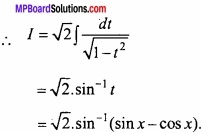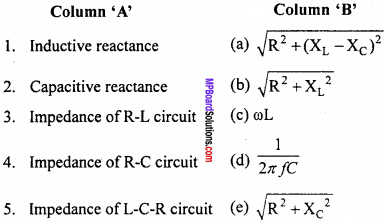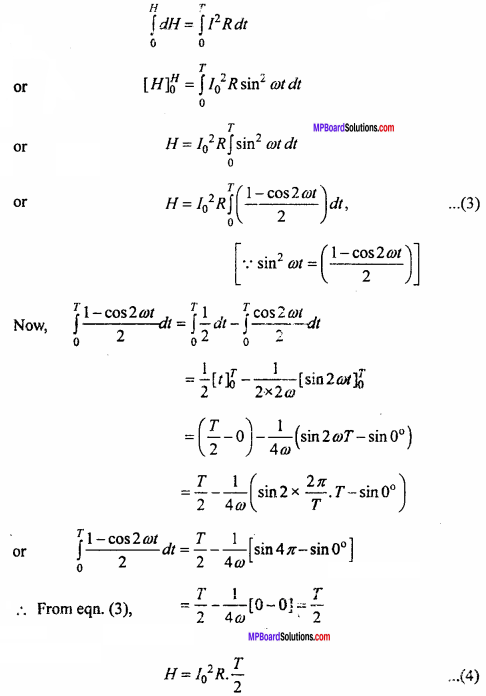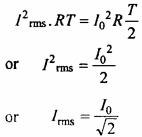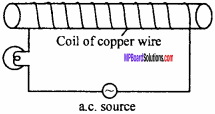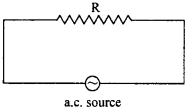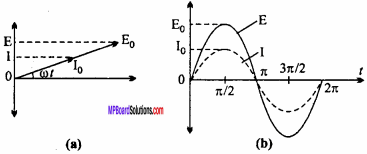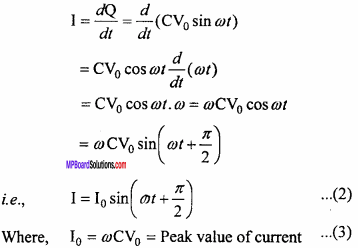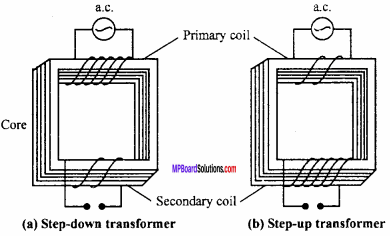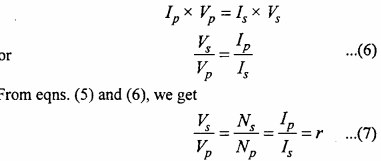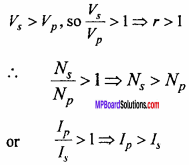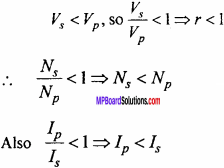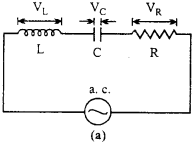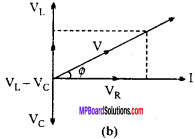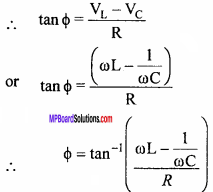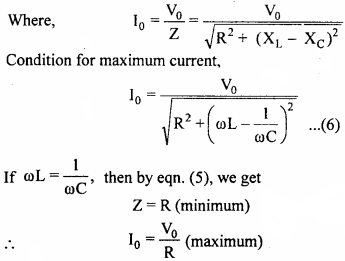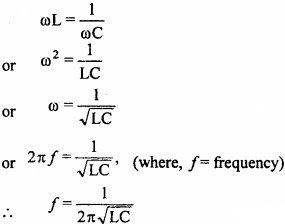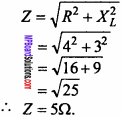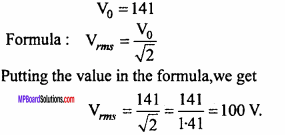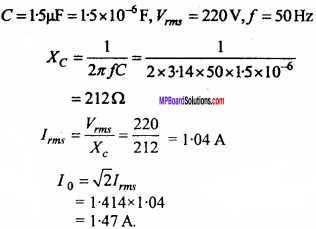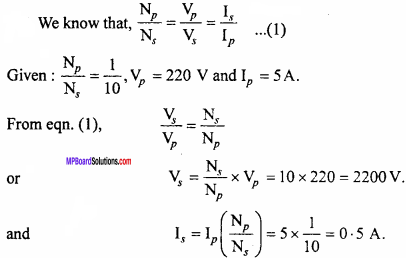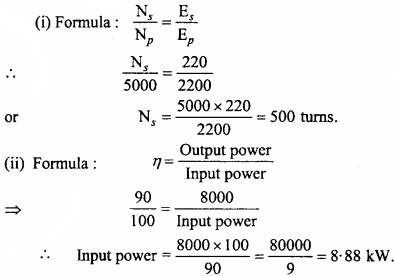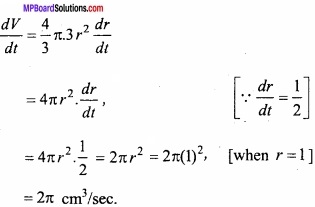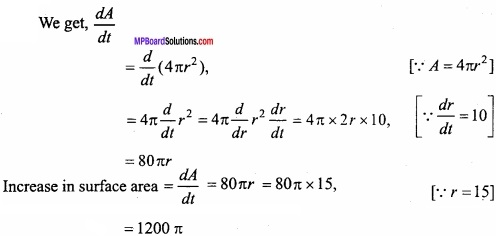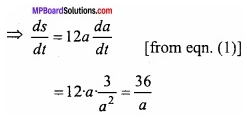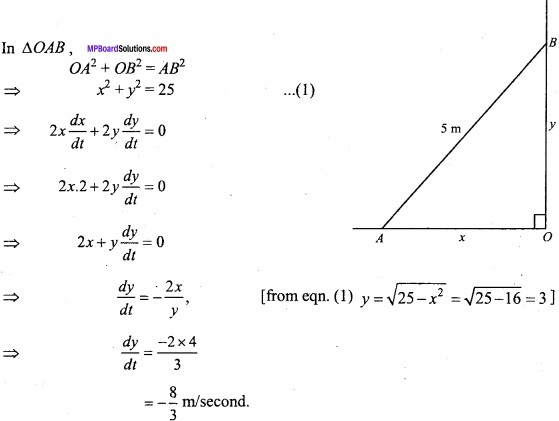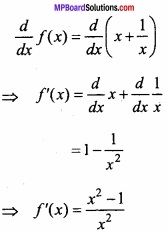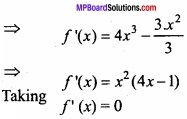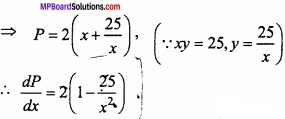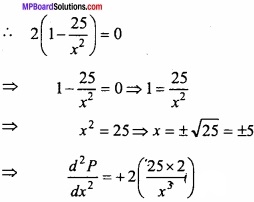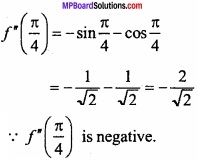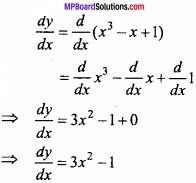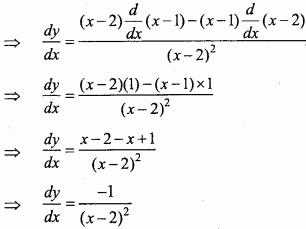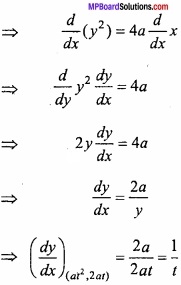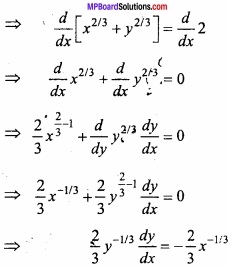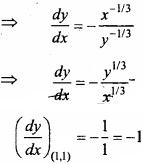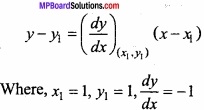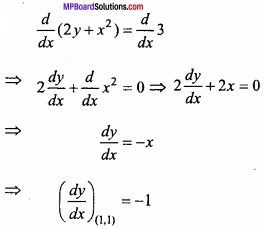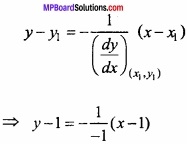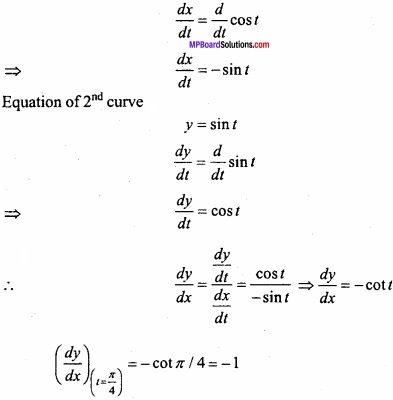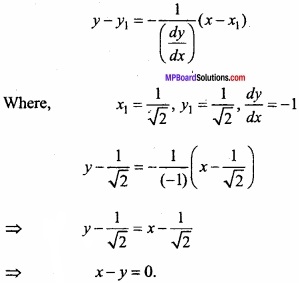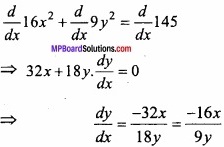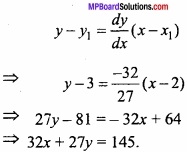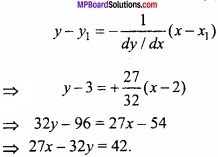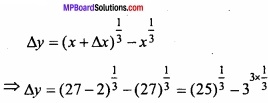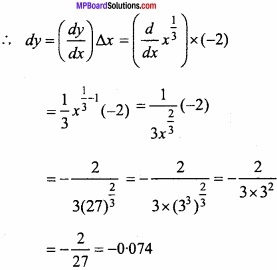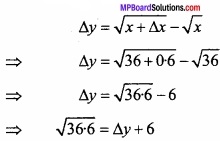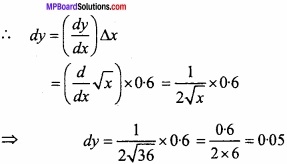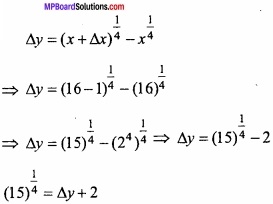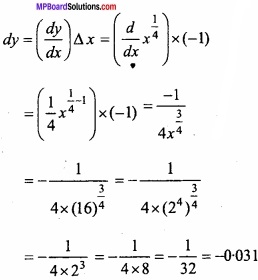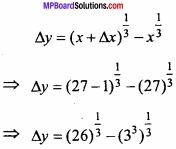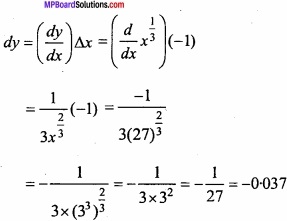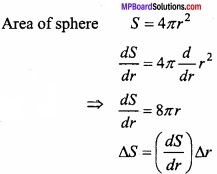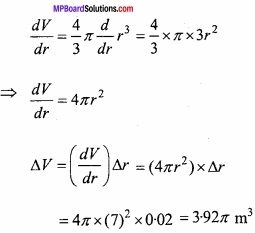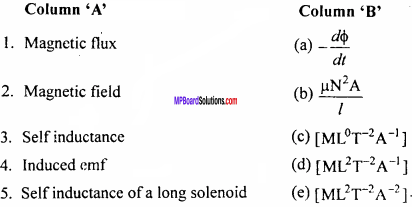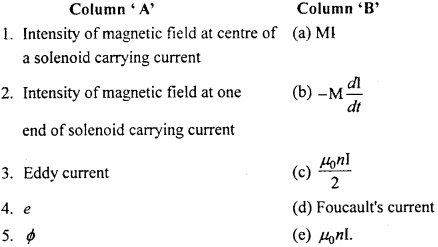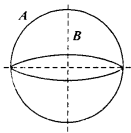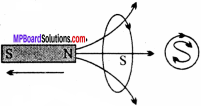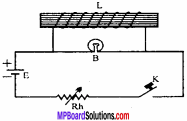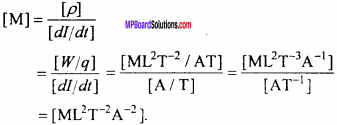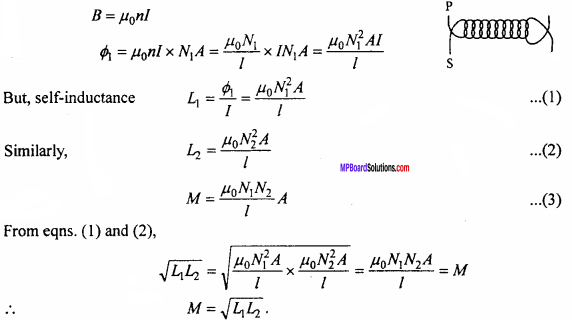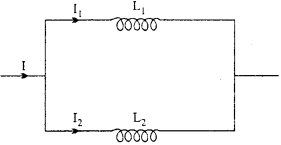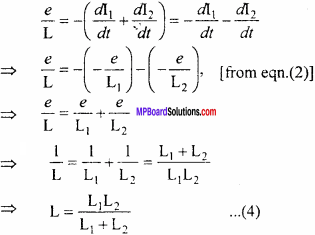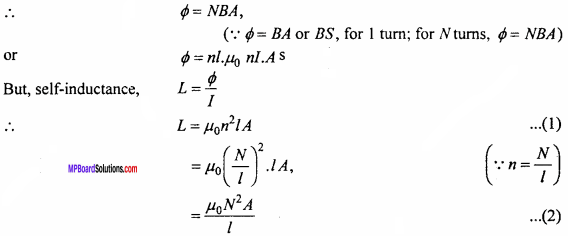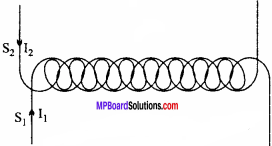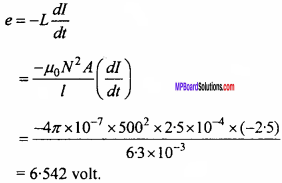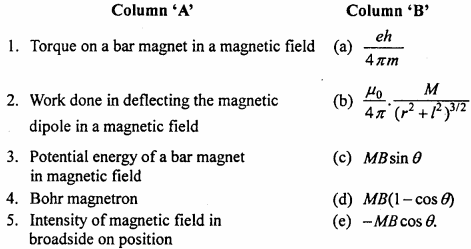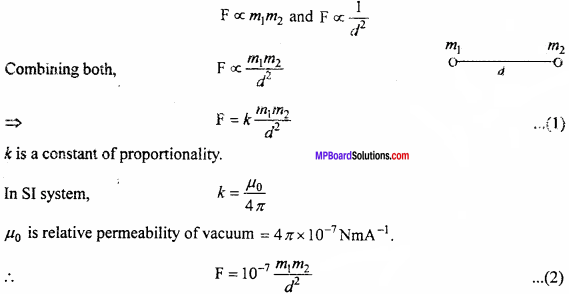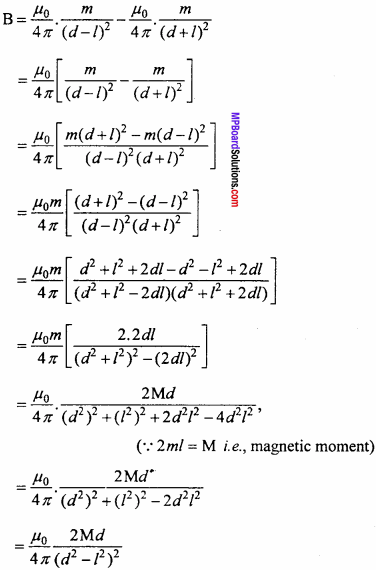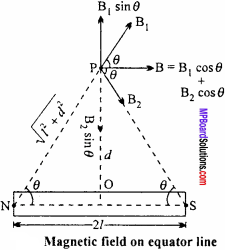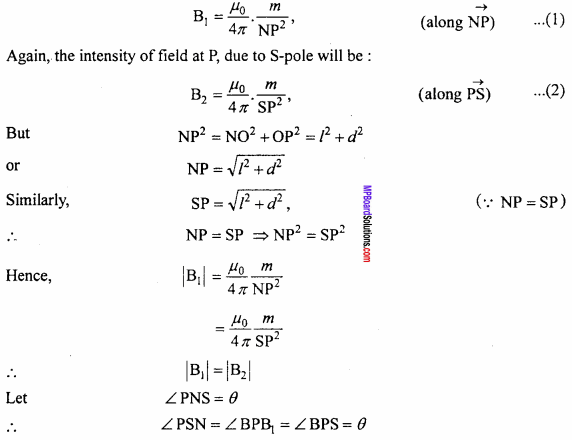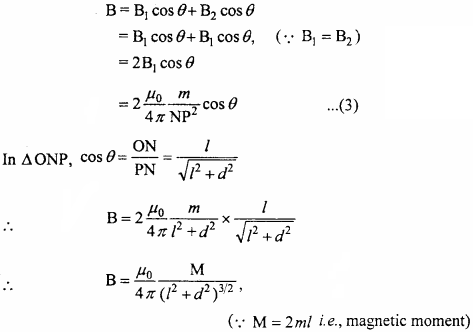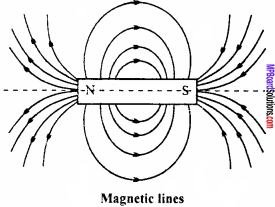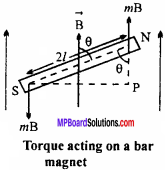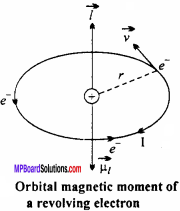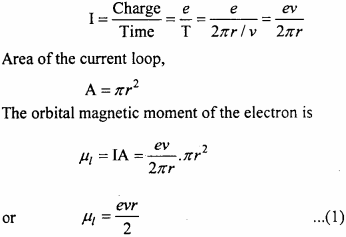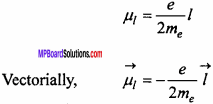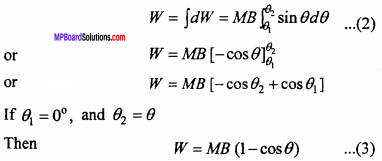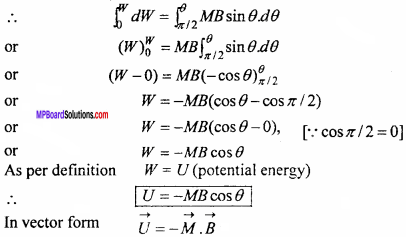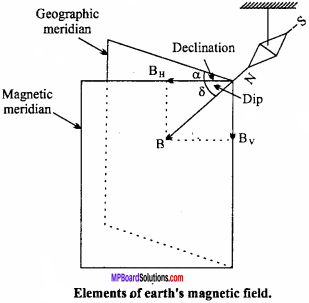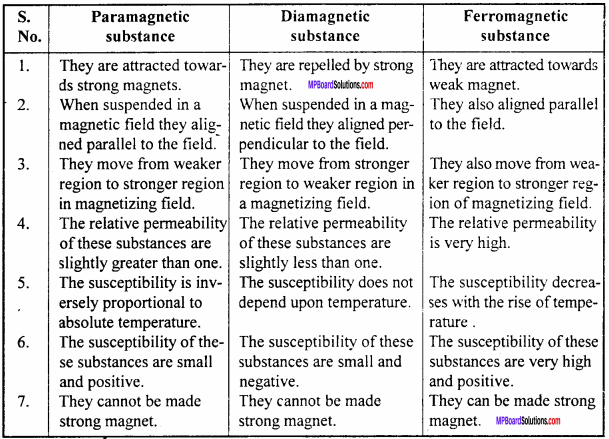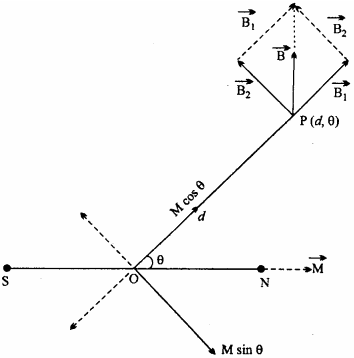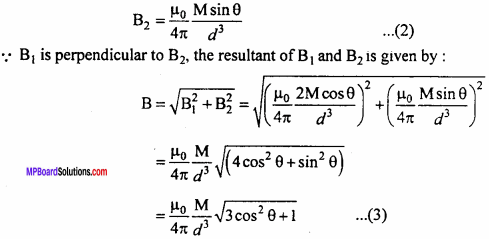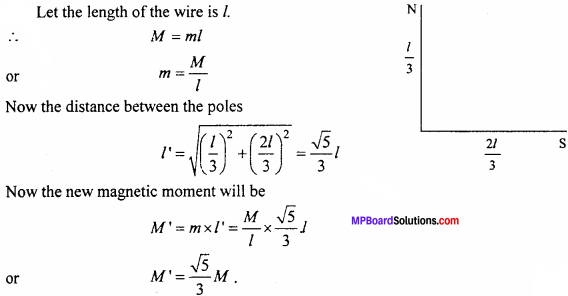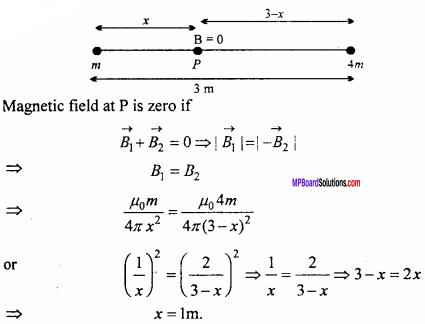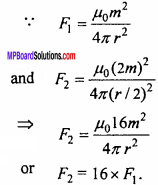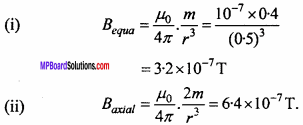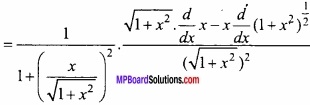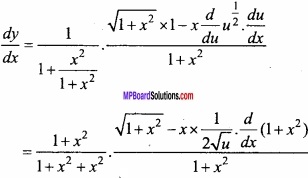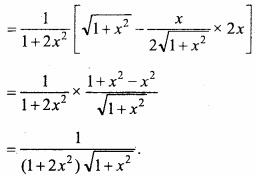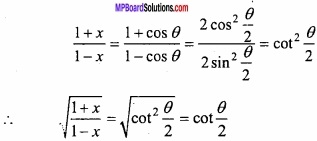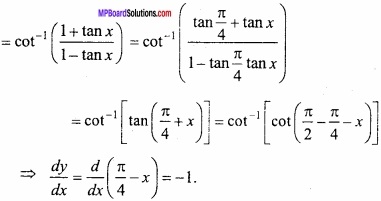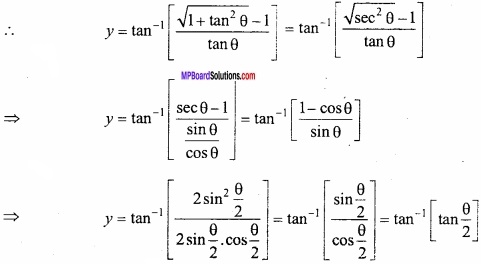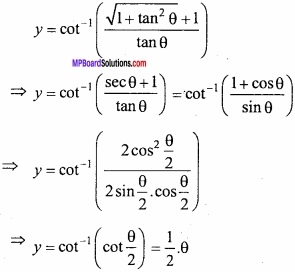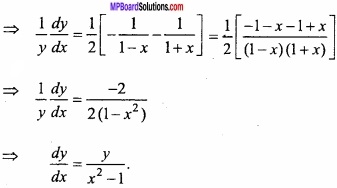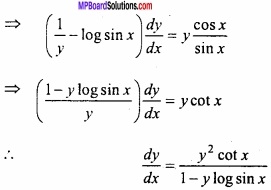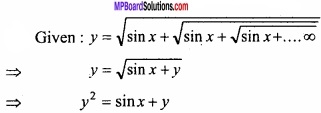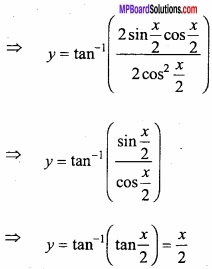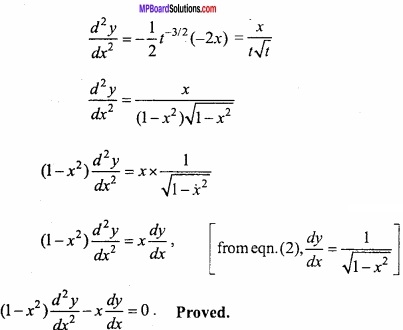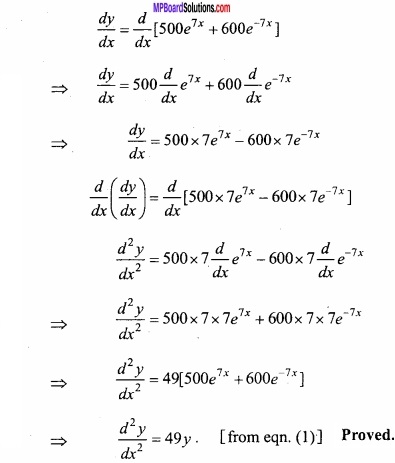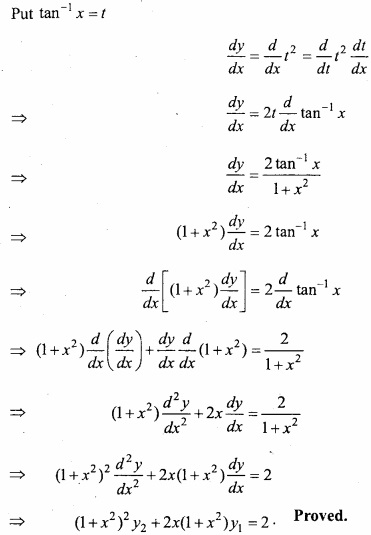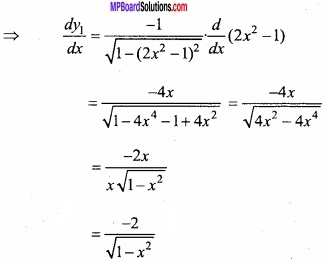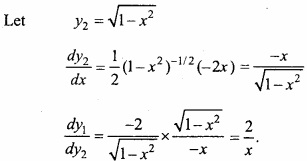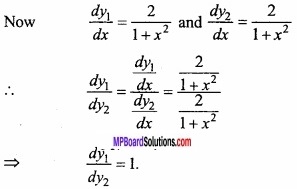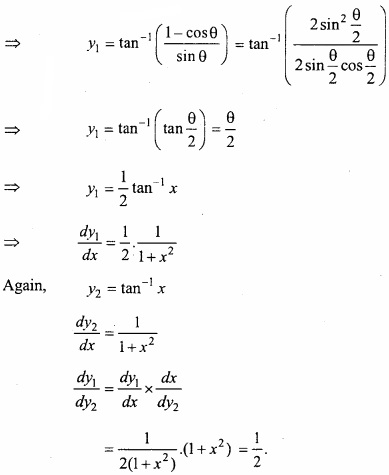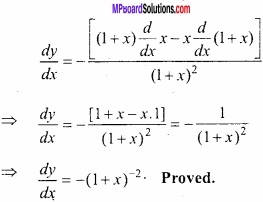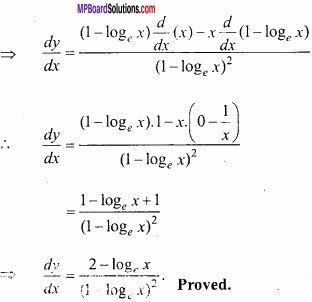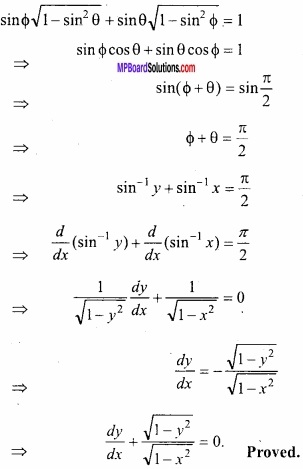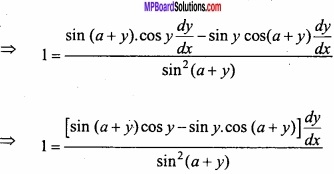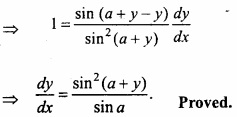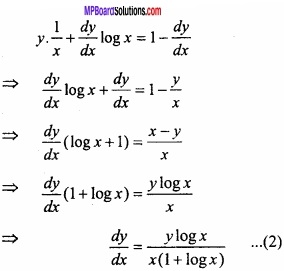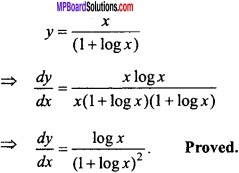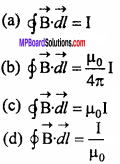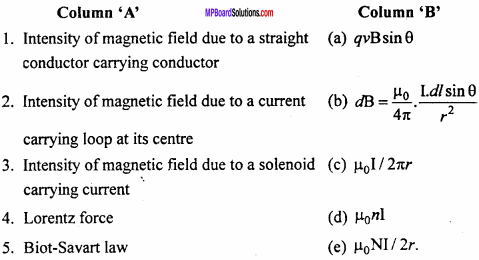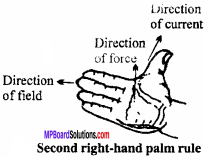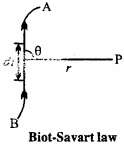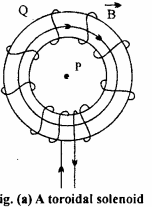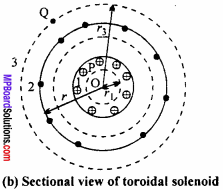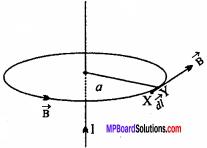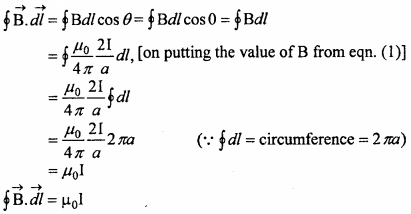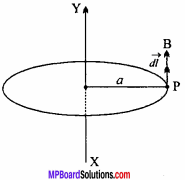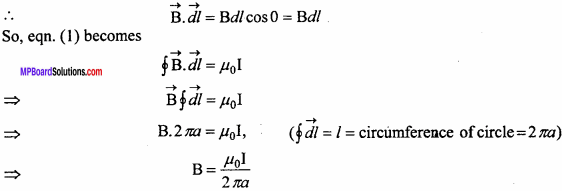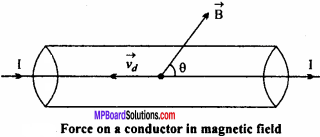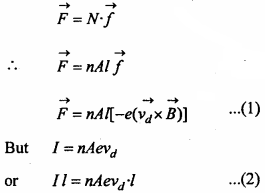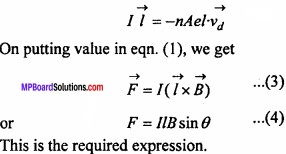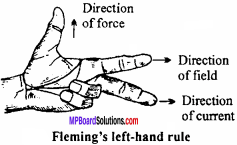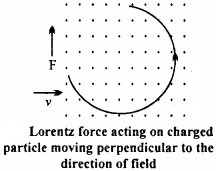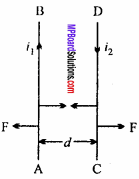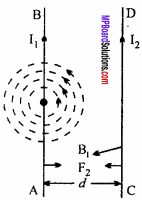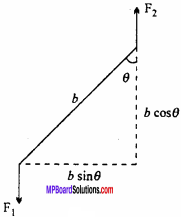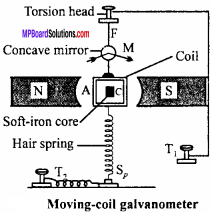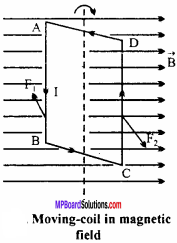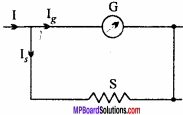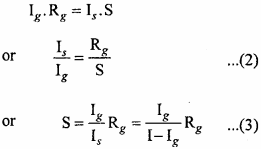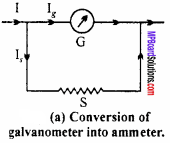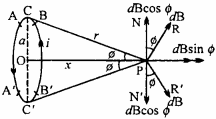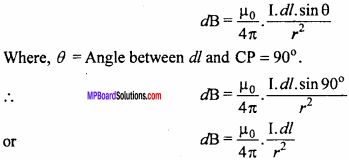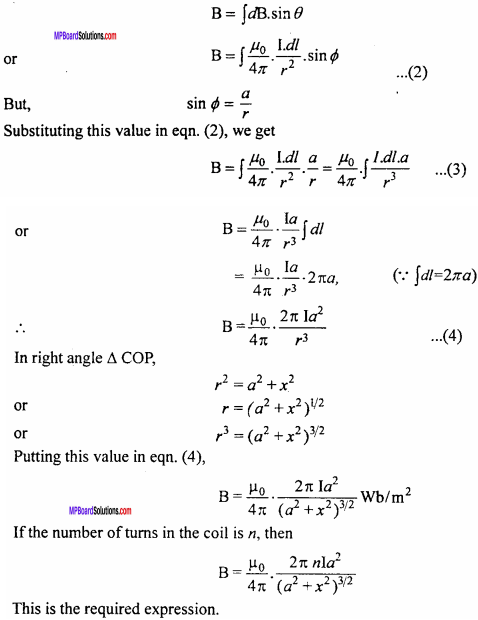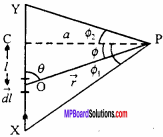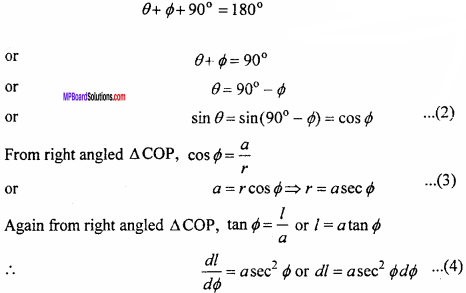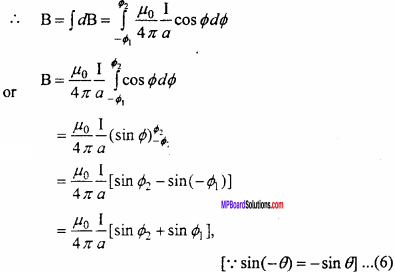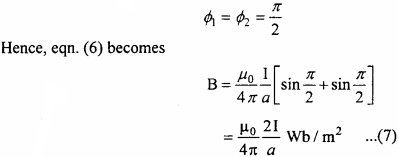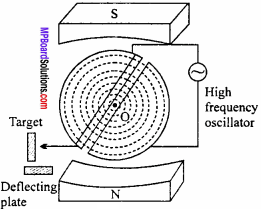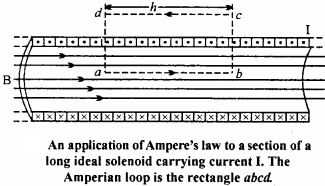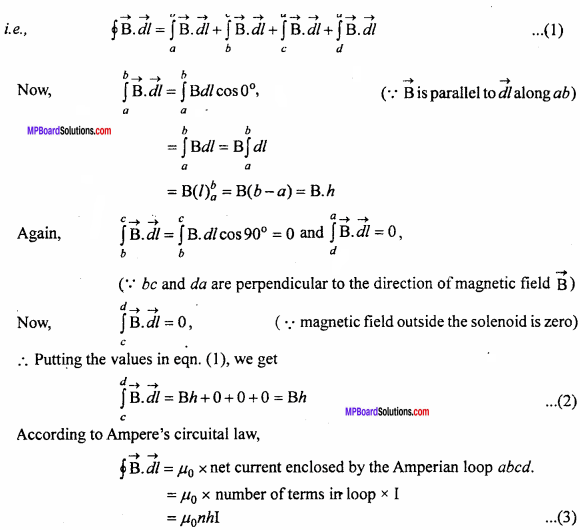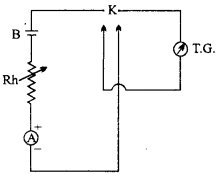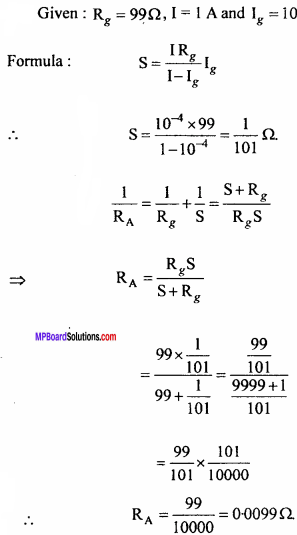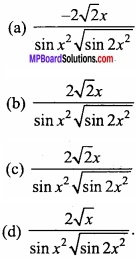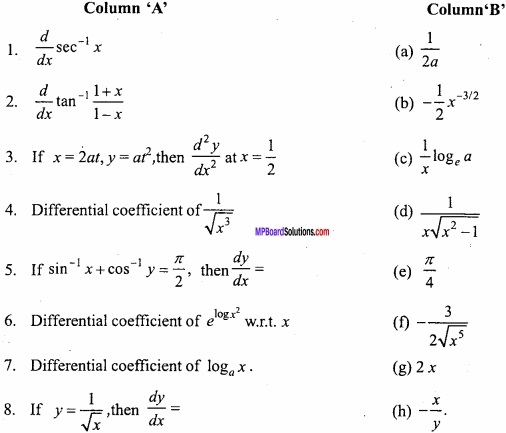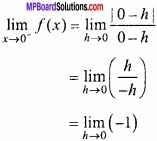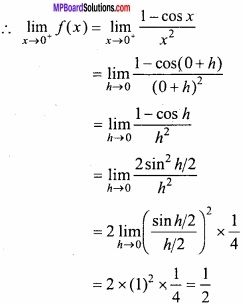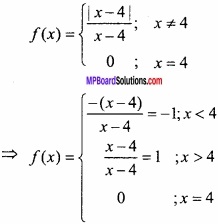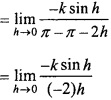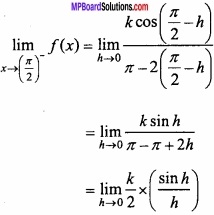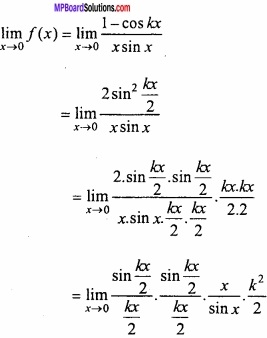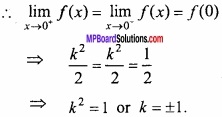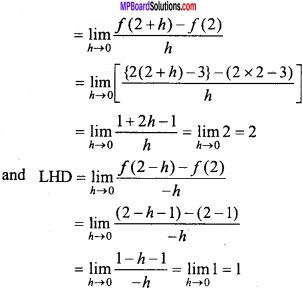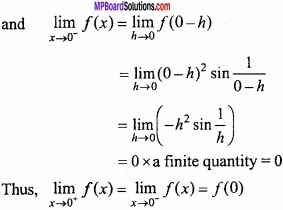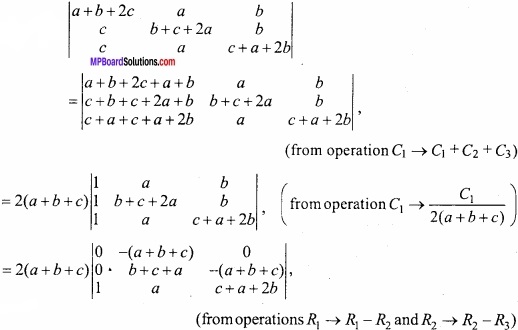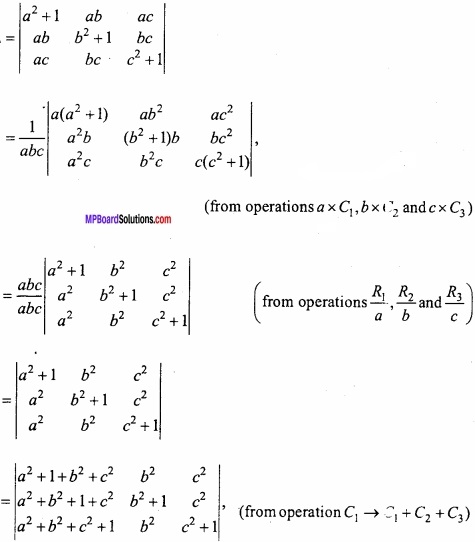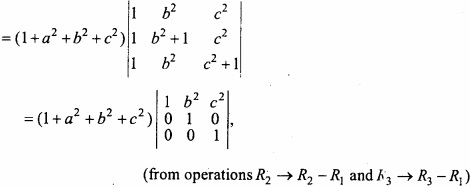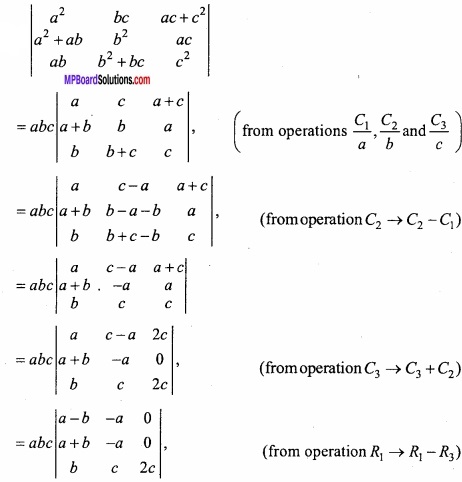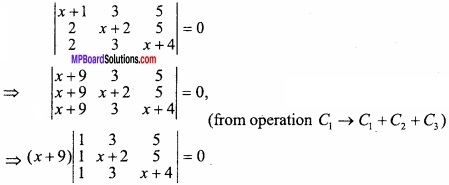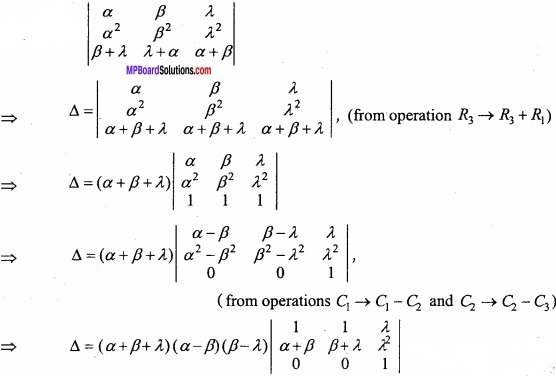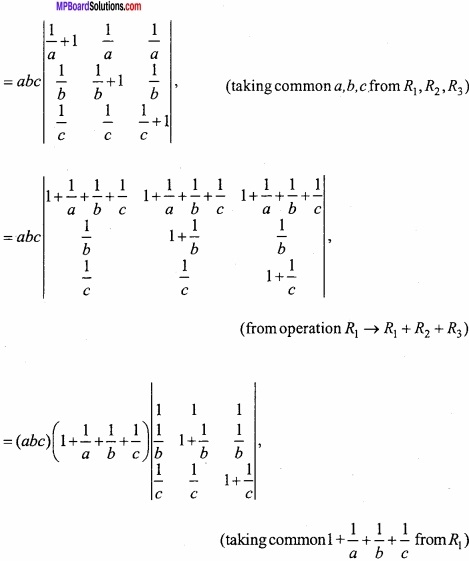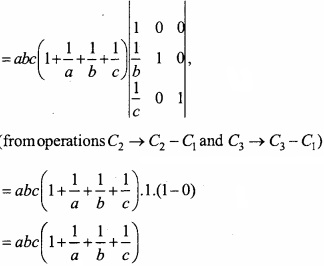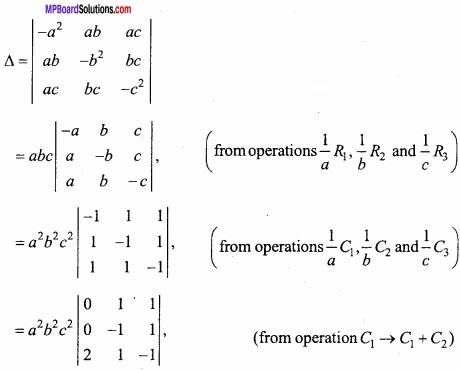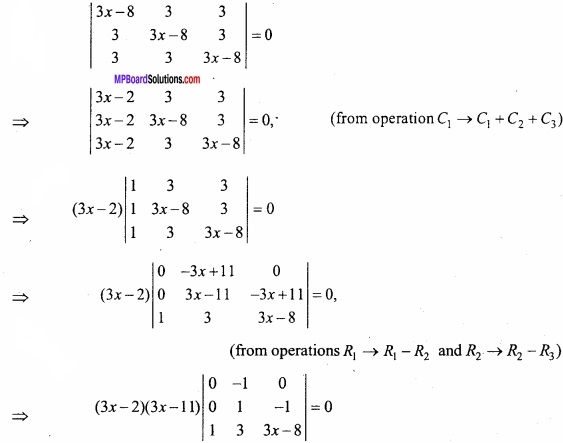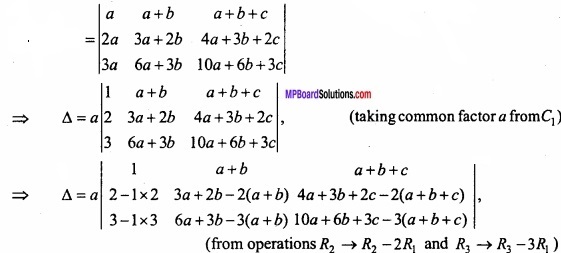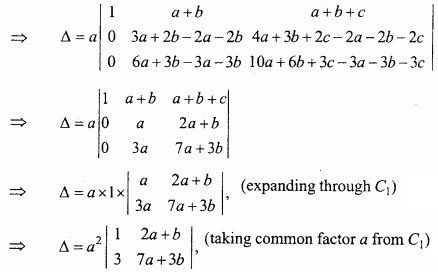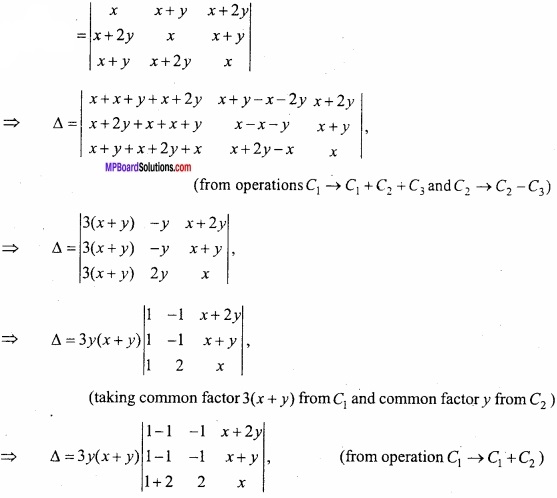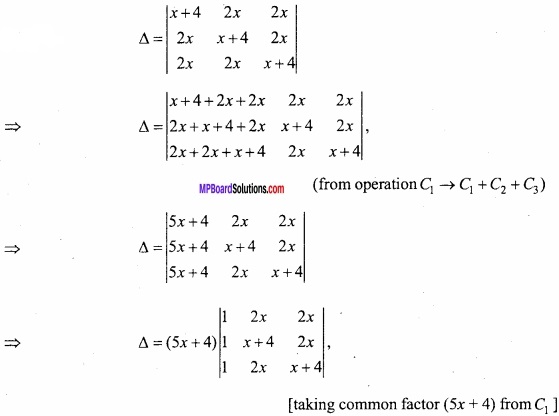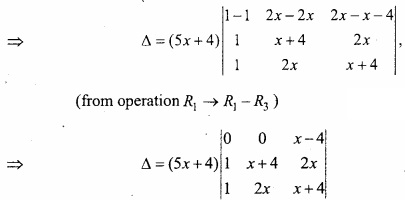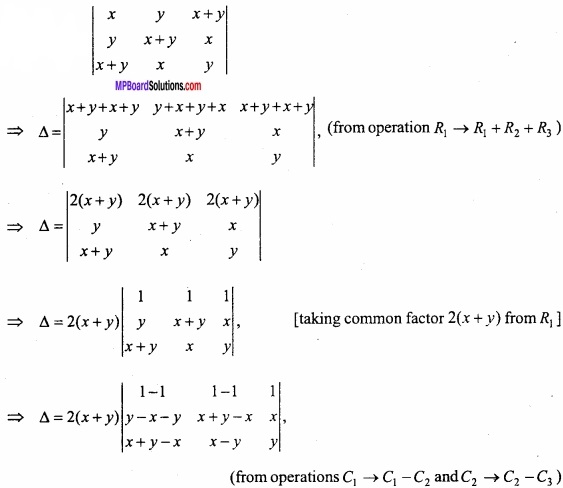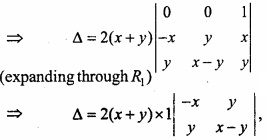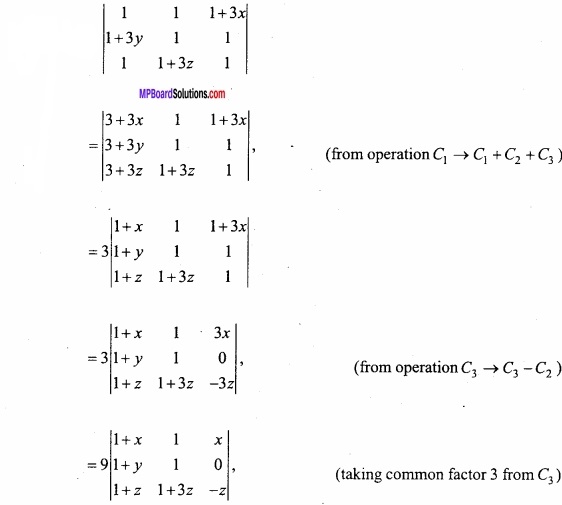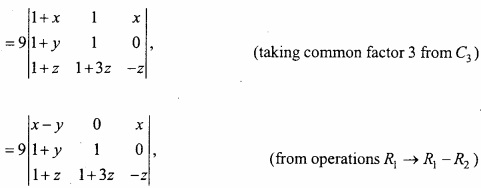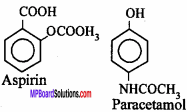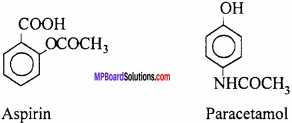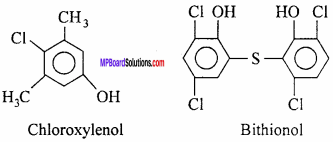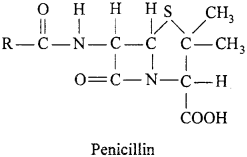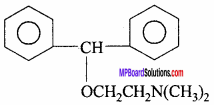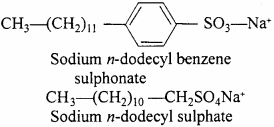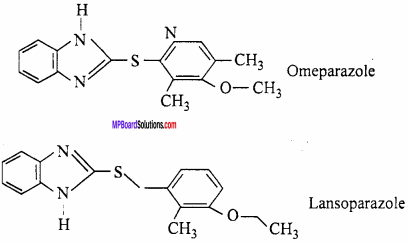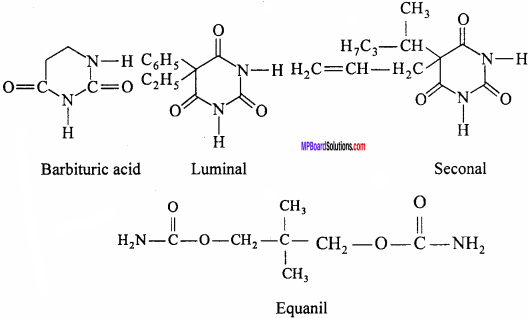MP Board Class 12th Maths Important Questions Chapter 7A Integration
Integration Important Questions
Integration Objective Type Questions:
Question 1.
Choose the correct answer:
Question 1.
The value of \(\int { \frac { sec^{ 2 }x }{ 1+tanx } } \) dx is:
(a) loge (l + tan x) + c
(b) tan x + c
(c) – cot x + c
(c) – cot x + c
(d) loge x + c
Answer:
(a) loge (l + tan x) + c
Question 2.
The value of \(\int { \frac { x }{ 4+x^{ 4 } } } \) dx is:
(a) \(\frac{1}{4}\) x2 + c
(b) \(\frac{1}{4}\) tan-1 \(\frac { x^{ 2 } }{ 2 } \)
(c) \(\frac{1}{2}\) tan-1 \(\frac { x^{ 2 } }{ 2 } \)
(d) None of these
Answer:
(a) \(\frac{1}{4}\) x2 + c
![]()
Question 3.
If \(\int \frac{2^{\frac{1}{x}}}{x^{2}}\) dx = k(2)1/x + c, then find the value of k is:
(a) \(\frac { -1 }{ log_{ e }2 } \)
(b) – loge 2
(c) -1
(d) \(\frac { 1 }{ 2 } \)
Answer:
(a) \(\frac { -1 }{ log_{ e }2 } \)
Question 4.
The value \(\int \frac{e^{x}(1+x)}{\cos ^{2}\left(x e^{x}\right)}\) dx is:
(a) 2 logecos(xex) + c
(b) sec(xex) + c
(c) tan(xex) + c
(d) tan(x + ex) + c
Answer:
(c) tan(xex) + c
![]()
Question 5.
If \(\int { xsinxdx } \) = -x cos x + α will be:
(a) sin x + c
(b) cos x + c
(c) c
(d) None of these
Answer:
(a) sin x + c
Question 2.
Fill in the blanks :
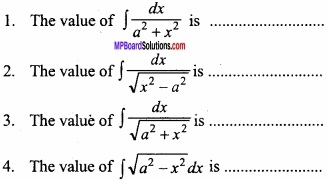
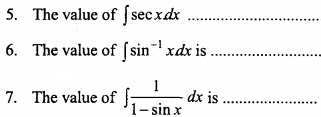
Answer:
- \(\frac{1}{2}\) tan-1 ( \(\frac{x}{a}\) ) + c
- log [x + \(\int { \frac { dx }{ \sqrt { x^{ 2 }-a^{ 2 } } } } \) + c
- log [x + \(\int { \frac { dx }{ \sqrt { a^{ 2 }-x^{ 2 } } } } \) + c
- \(\frac{x}{2}\) \(\int { \frac { dx }{ \sqrt { a^{ 2 }-x^{ 2 } } } } \) + \(\frac { a^{ 2 } }{ 2 } \) sin-1 ( \(\frac{x}{a}\) ) + c
- log(sec x + tan x) + c
- sin-1 x + \(\sqrt { 1-x } \) + c
- tan x + sec x.
Question 3.
Write True/False:
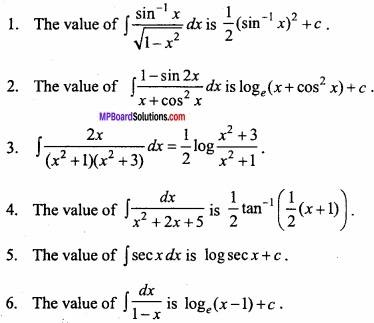
Answer:
- True
- True
- False
- True
- False
- False
Integration Very Short Answer Type Questions
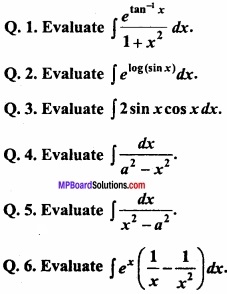
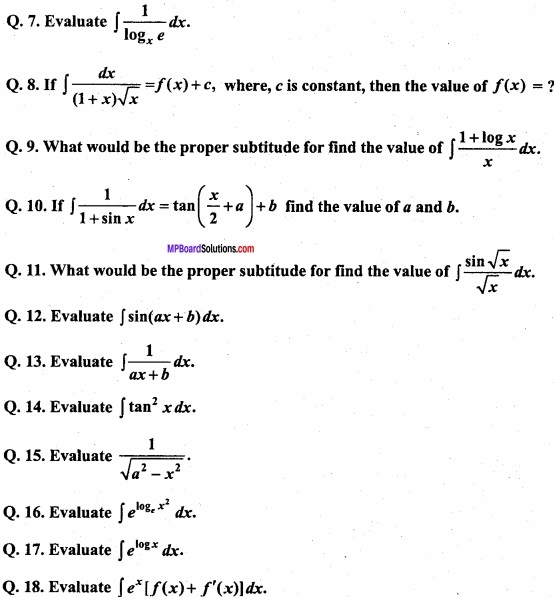
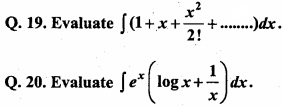
Answer:
- \(e^{ tan-1x }\) + c
- – cos x + c
- sin2 x + c
- \(\frac{1}{2a}\) log \(\frac { a+x }{ a-x } \)
- \(\frac{1}{2a}\) log \(\frac { x-a }{ x+a } \)
- \(\frac { e^{ x } }{ x } \) + c
- x log \(\frac { x }{ e } \) + c
- 2 tan-1\(\sqrt{x}\)
- 1 + log x = t
- a = – \(\frac { \pi }{ 4 } \), b = 3
- x = t2
- – \(\frac{1}{a}\) cos(ax + b)
- \(\frac{1}{a}\) log (ax + b)
- tan x – x + c
- sin-1 \(\frac{x}{a}\)
- \(\frac { x^{ 3 } }{ 3 } \) + c
- \(\frac { x^{ 3 } }{ 2 } \) + c
- exf(x) + c
- ex
- ex log x + c.
Integration Short Answer Type Questions
Question 1.
Evaluate:
\(\int \frac{\cos 2 x+2 \sin ^{2} x}{\cos ^{2} x} dx\)? (CBSE 2018)
Solution:
Let I = \(\int \frac{\cos 2 x+2 \sin ^{2} x}{\cos ^{2} x} d x\)
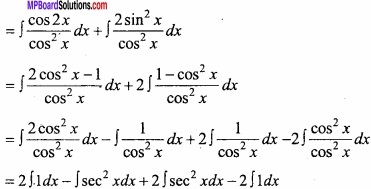
= \(\int { sec^{ 2 }xdx } \)
= tan x + c.
Question 2.
Evaluate \(\int { \frac { 1-sinx }{ cos^{ 2 }x } } \) dx? (NCERT)
Solution:
Let I = \(\int { \frac { 1-sinx }{ cos^{ 2 }x } } \)
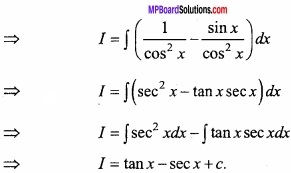
Question 3.
Evaluate \(\int \frac{2-3 \sin x}{\cos ^{2} x} d x\) dx? (NCERT)
Solution:
Let I = \(\int \frac{2-3 \sin x}{\cos ^{2} x} d x\) dx
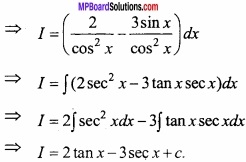
Question 4.
Evaluate \(\int \sin ^{-1}(\cos x) d x\) dx? (NCERT)
Solution:
I = \(\int \sin ^{-1}(\cos x) d x\) dx
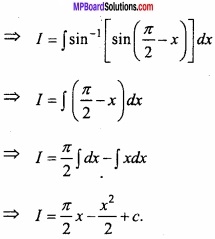
Question 5.
Evaluate \(\int { \frac { dx }{ 1+cos2x } } \)?
Solution:
Let I =
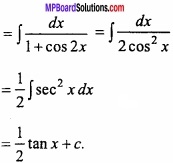
Question 6.
(A) Evaluate \(\int { tan^{ -1 }xdx } \)?
Solution:
Let
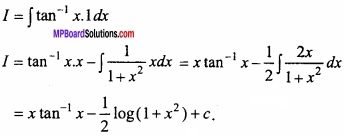
(B) Evaluate \(\int { sin^{ -1 }xdx } \) and \(\int { cos^{ -1 }xdx } \)?
(Do it by yourself)
Question 7.
Evaluate \(\int { sin^{ 2 }xdx } \)?
Solution:
Let
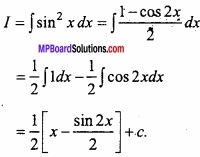
Question 8.
Evaluate \(\int { \frac { cosx }{ cos(x-\alpha ) } } \) dx?
Solution:
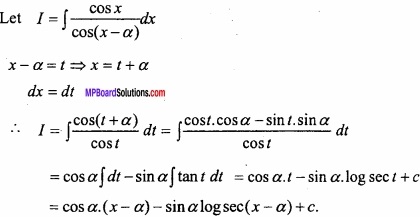
Question 9.
(A) Evaluate \(\int { \frac { 1 }{ \sqrt { 1+cosx } } } \) dx?
Solution:
Let
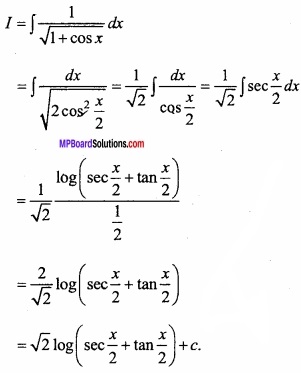
(B) Evaluate \(\int { \sqrt { 1+cos2xdx } } \)?
Solution:
Solve like Q.No 9 (B)
![]()
Question 10.
(A) Evaluate \(\int { \frac { e^{ x }(1+x) }{ cos^{ 2 }(xe^{ x }) } } \) dx?
Solution:
Let
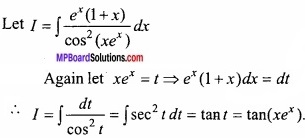
(B) Evaluate \(\int { \frac { e^{ tan-1x } }{ 1+x^{ 2 } } } \) dx?
Solution:
Let
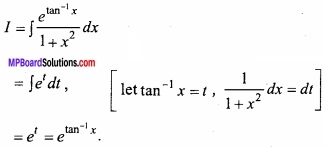
Question 11.
Evaluate \(\int { \frac { dx }{ 1-sinx } } \)?
Solution:
Let
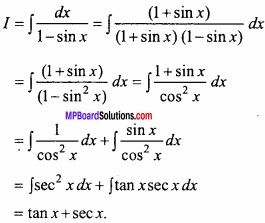
Question 12.
Evaluate \(\int { \frac { logx }{ x } } \) dx?
Solution:
Given:
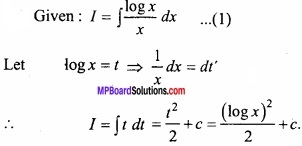
Question 13.
(A) Evaluate \(\int { \frac { dx }{ 1-cosx } } \)?
Solution:
Let
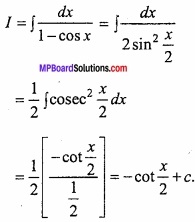
(B) Evaluate \(\int { \frac { logx }{ x } } \) dx?
Solution:
Let

Question 14.
Evaluate \(\int { \frac { dx }{ 1+sinx } } \)?
Solution:
Let
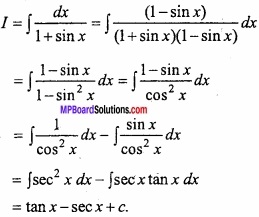
Question 15.
Evaluate \(\int { \frac { cos\sqrt { x } }{ \sqrt { x } } } \) dx?
Solution:
Let
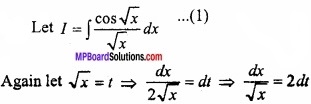

Question 16.
Evaluate \(\int { \frac { 1-cos2x }{ 1+cos2x } } \) dx?
Solution:
Let
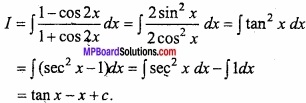
Question 17.
Integrate \(\frac { x^{ 4 } }{ x^{ 2 }+1 } \) with respect to x?
Solution:
Let
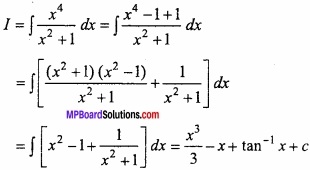
Question 18.
Find the value of \(\int { \frac { sec^{ 2 }(logx) }{ x } } \) dx?
Solution:
Let I = \(\int { \frac { sec^{ 2 }(logx) }{ x } } \) dx
Put, log x = t
⇒ \(\frac { 1 }{ x } \) dx = dt
∴ I = ∫sec2 t dt
⇒ I = tan x + c
⇒ tan(log x) + c
Question 19.
Find the value of \(\int { \frac { sin(logx) }{ x } } \) dx?
Solution:
Let I = \(\int { \frac { sin(logx) }{ x } } \) dx
Put, log x = t
⇒ \(\frac { 1 }{ x } \) dx = dt
∴ I = ∫sin t dt = -cos t + c
⇒ I = – cos (log x) + c
![]()
Question 20.
Find the value of \(\int { \frac { cos(logx) }{ x } } \) dx?
Solution:
Solve like Q.No.19
Question 21.
(A) Find the value of \(\int { tan^{ 2 }xdx } \)?
Solution:
Let I = \(\int { tan^{ 2 }xdx } \) = ∫(sec2 x – 1) dx
= ∫sec2 x dx – ∫1dx = tan x – x.
(B) Find the value of \(\int { cot^{ 2 }xdx } \)?
Solution:
Let I = \(\int { cot^{ 2 }xdx } \) = ∫(cosec2 x – 1) dx
= ∫cosec2 x dx – ∫1.dx = – cot x – x.
![]()
Question 22.
Find the value of \(\int { \frac { sinx }{ 1+cosx } } \) dx?
Solution:
Let I = \(\int { \frac { sinx }{ 1+cosx } } \) dx
= ∫\(\frac { 1 }{ t } \) dt, (Put 1+cos x = dt ⇒ sin x dx = dt)
= log t
= log (1 + cos x).
Question 23.
Find the value \(\int { \frac { sin^{ -1 }x }{ \sqrt { 1-x^{ 2 } } } } \) dx?
Solution:

Integration Long Answer Type Questions – I
Question 1.
Find the value of \(\int { \sqrt { \frac { a+x }{ a-x } } } \) dx?
Solution:
Let I = \(\int { \sqrt { \frac { a+x }{ a-x } } } \) dx
Again let x = a cos θ ⇒ dx = – a sin θ dθ

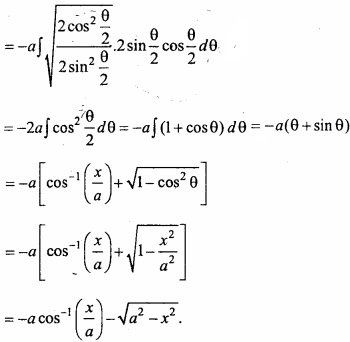
Question 2.
Evaluate \(\int\left[\frac{1}{(\log x)^{2}}-\frac{2}{(\log x)^{3}}\right]\) dx?
Solution:
Let I = \(\int\left[\frac{1}{(\log x)^{2}}-\frac{2}{(\log x)^{3}}\right]\)
Again let log x = t ⇒ x = et ⇒ dx = etdt

Question 3.
Evaluate \(\int { sin^{ -1 } } \) xdx?
Solution:
Let
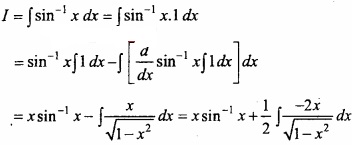
Again let 1 – x2 t ⇒ – 2x dx = dt


Question 4.
Evaluate \(\int { cos^{ -1 }xdx } \)?
Solution:
Let
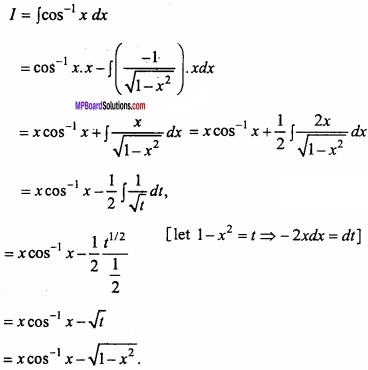
Question 5.
(A) Evaluate \(\int { \frac { x^{ 2 } }{ 1+x } } \) dx?
Solution:
Let
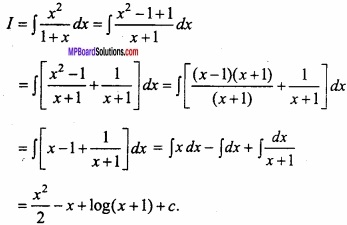
(B) Evaluate \(\int { \frac { x }{ 1+x^{ 4 } } } \) dx?
Solution:
Let
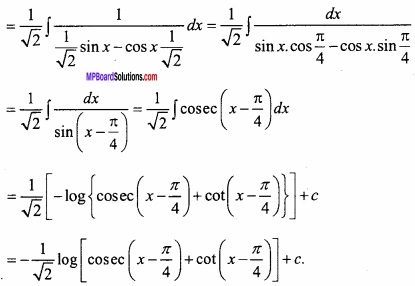
= \(\frac{1}{2}\) tan-1 t,
= \(\frac{1}{2}\) tan-1 x2
Question 6.
Evaluate \(\int { \frac { 1 }{ sinx-cosx } } \) dx?
Solution:
Let I = \(\int { \frac { 1 }{ sinx-cosx } } \) dx

Question 7.
Evaluate \(\int { \frac { dx }{ e^{ x }+1 } } \)?
Solution:
Let

Question 8.
Evaluate \(\int { sec^{ 3 }xdx } \)?
Solution:
Let

= sec x tan x – ∫sec x tan x tan x dx
= sec x tan x – ∫sec x tan2 x dx
= sec x tan x – ∫sec x (sec2 x – 1) dx
= sec x tan x – ∫sec3 xdx +∫sec x dx
⇒ I = sec x tan x – I + log(sec x + tan x)
⇒ 2I = sec x tan x + log (sec x + tan x)
⇒ I = \(\frac{1}{2}\) [sec x tan x + log (sec x + tan x)].
Question 9.
Evaluate \(\int { \frac { dx }{ x^{ 2 }-a^{ 2 } } } \)?
Solution:
Let

We have to break the term with partial fraction,
img
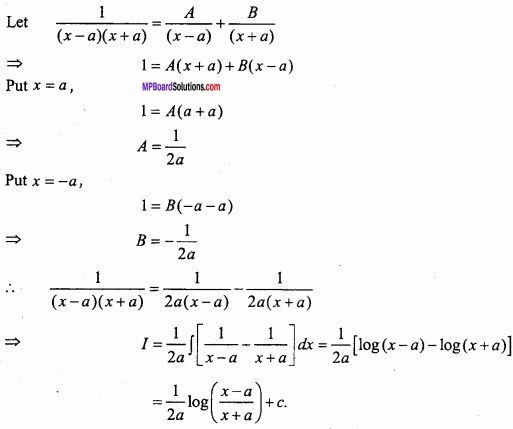
Question 10.
Evaluate \(\int { \frac { 3x }{ (x-2)(x+1) } } \) dx?
Solution:
Let \(\int { \frac { 3x }{ (x-2)(x+1) } } \) = \(\frac { A }{ (x-2) } \) + \(\frac { B }{ (x+1) } \) ………………… (1)
⇒ \(\frac { 3x }{ (x-2)(x+1) } \) = \(\frac { A(x+1)+B(x-2) }{ (x-2)(x+1) } \)
⇒ 3x = A(x + 1) + B (x – 2)
⇒ 3x = (A + B)x + (A – 2B) …………………… (2)
Comparing the coefficient of x from both sides,
3 = A + B
0 = A – 2B
3 = 3B ⇒ B = 1
and A = 2B = 2
image 40 40 40
= 2 log(x – 2) + log (x + 1) + c.
![]()
Question 11.
Evaluate \(\int { \frac { x^{ 2 }+1 }{ x^{ 4 }-x^{ 2 }+1 } } \) dx?
Solution:
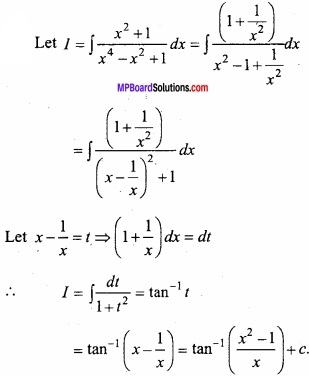
Question 12.
Evaluate \(\int { \frac { x^{ 2 }+1 }{ x^{ 4 }+x^{ 2 }+1 } } \) dx?
Solution:
Solve like Q.No.11.
Answer:

Question 13.
Evaluate \(\int { \frac { dx }{ \sqrt { x^{ 2 }+2x+3 } } } \)?
Solution:
Let
![]()
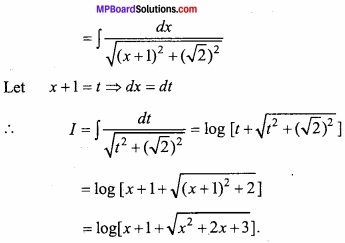
Question 14.
Integrate \(\frac { 1 }{ 1+sin^{ 2 }x } \) with respect to x?
Solution:
Let
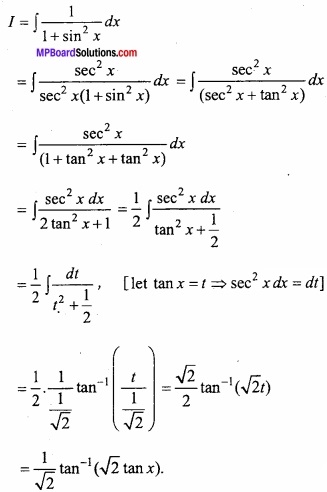
Question 15.
Evaluate \(\int { \frac { cos2x }{ (cosx+sinx)^{ 2 } } } \) dx? (NCERT)
Solution:
Let
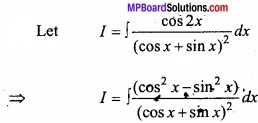

Taking cos x + sin x = t
\(\frac { d }{ dx } \) (cosx + sinx) = \(\frac { dt }{ dx } \)
⇒ (-sinx + cos x) = \(\frac { dt }{ dx } \)
∴ I = ∫ \(\frac { dt }{ t } \)
⇒ I = logt + c
⇒ I = log(cos x + sinx) + c.
Question 16.
Evaluate \(\int { \frac { 1+tanx }{ x+logsecx } } \)dx?
Solution:
Let
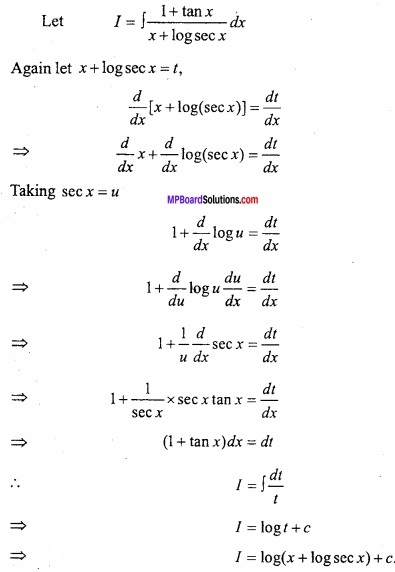
Question 17.
Evaluate \(\int { \frac { cotx }{ log(sinx) } } \) dx?
Solution:
Let I = \(\int { \frac { cotx }{ log(sinx) } } \) dx
Again let log(sin x) = t
\(\frac{d}{dx}\) log (sin x) = \(\frac{dt}{dx}\)
Taking sin x = u,
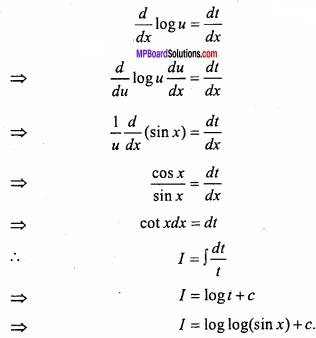
⇒ I = log t + c
⇒ I = log log(sin x) + c.
Question 18.
Evaluate \(\int { \frac { 2cosx-3sinx }{ 6cosx+4sinx } } \) dx? (NCERT)
Solution:
Let I = \(\int { \frac { 2cosx-3sinx }{ 6cosx+4sinx } } \) dx
Again let 6 cosx + 4 sin x = t,
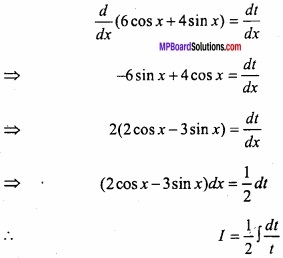

Question 19.
Evaluate \(\int { e^{ 3logx } } (x^{ 4 }+1)^{ -1 }\) dx? (NCERT)
Solution:
Let I = \(\int { e^{ 3logx } } (x^{ 4 }+1)^{ -1 }\) dx
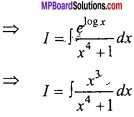
Put x4 + 1 = t,
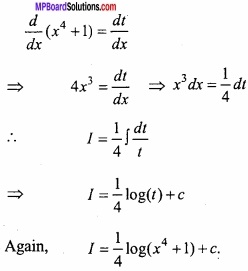
Question 20.
Evaluate \(\int { \frac { dx }{ x-\sqrt { x } } } \)? (NCERT)
Solution:
Let I = \(\int { \frac { dx }{ x-\sqrt { x } } } \)
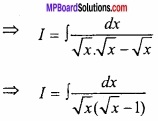
Put \(\sqrt{x}\) – 1 = t
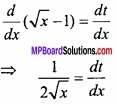
Question 21.
Evaluate \(\int { \frac { dx }{ 1+3sin^{ 2 }x } } \)?
Solution:
Let I = \(\int { \frac { dx }{ 1+3sin^{ 2 }x } } \)
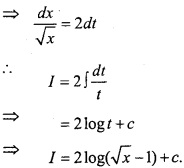
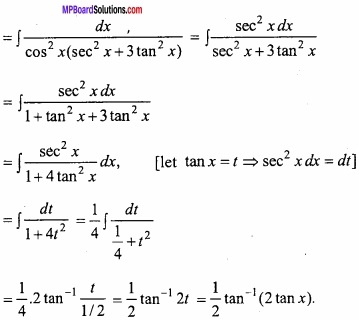
Integration Long Answer Type Questions – II
Question 1.
Evaluate \(\int \sin ^{-1}\left(\frac{2 x}{1+x^{2}}\right) d x\) dx?
Solution:
Let I = \(\int \sin ^{-1}\left(\frac{2 x}{1+x^{2}}\right) d x\) dx
Again let x = tan θ ⇒ dx = sec2 θ dθ
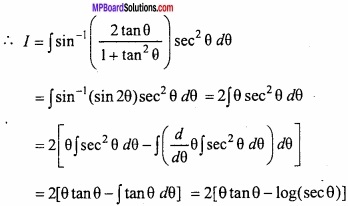

Question 2.
Integrate \(\frac{e^{m \tan ^{-1} x}}{\left(1+x^{2}\right)^{\frac{3}{2}}}\) with respect to x?
Solution:
Let tan-1 x = t ⇒ x = tan t
dx = sec2 t dt
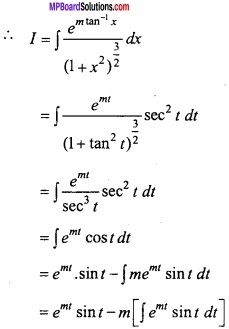
= emtsin t – m[emt(-cos t) – \(\int { me^{ mt } } \) (-cos t) dt]
= emtsin t + memtcos t – m2 \(\int { e^{ mt } } \) cos t dt
= emt (sin t + m cos t) – m2 I
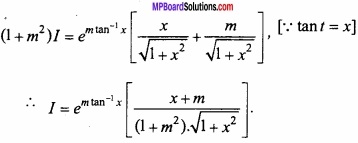
Question 3.
Evaluate \(\int { \frac { x^{ 2 }tan^{ -1 }x }{ 1+x^{ 2 } } } \) dx?
Solution:
Let I = \(\int { \frac { x^{ 2 }tan^{ -1 }x }{ 1+x^{ 2 } } } \) dx
Let x = tan θ ⇒ θ = tan-1 x
⇒ dx = sec2 θdθ
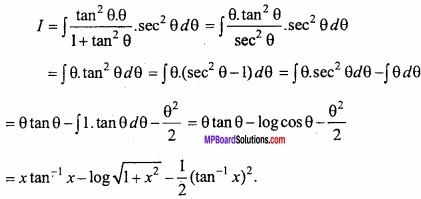
Question 4.
Evaluate \(\int { tan^{ -1 }\frac { 2x }{ 1+x^{ 2 } } } \) dx?
Solution:
Let I = \(\int { tan^{ -1 }\frac { 2x }{ 1+x^{ 2 } } } \) dx
Let x = tan θ ⇒ dx = sec2 θdθ
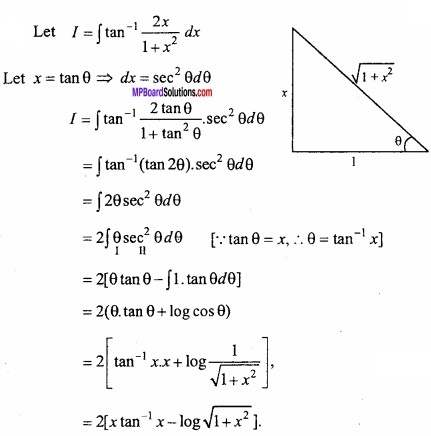
Question 5.
Evaluate \(\int { \frac { xtan^{ -1 }x }{ (1+x^{ 2 })^{ 3/2 } } } \) dx?
Solution:
Let I = \(\int { \frac { xtan^{ -1 }x }{ (1+x^{ 2 })^{ 3/2 } } } \) dx
Let x = tan θ ⇒ dx = sec2 θdθ
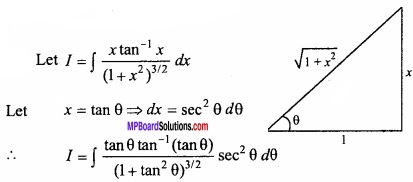
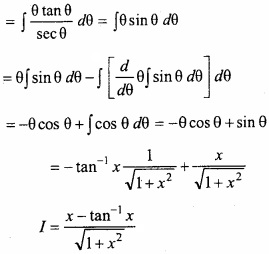
Question 6.
Evaluate \(\int { \frac { dx }{ 3+2cosx } } \)?
Solution:
Let I = \(\int { \frac { dx }{ 3+2cosx } } \)
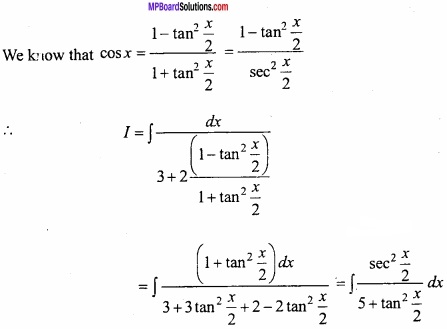
Again let tan \(\frac { x }{ 2 }\) = t,
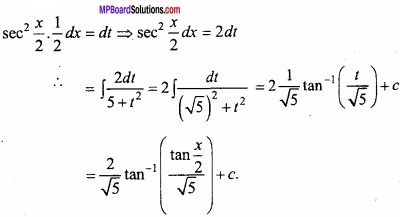
Question 7.
Evaluate \(\int { \frac { dx }{ 4+5cosx } } \)?
Solution:
Solve like Q.No.6.
Question 8.
Evaluate \(\int { \frac { dx }{ 5-3cosx } } \)?
Solution:
Solve like Q.No.6.
Question 9.
Evaluate \(\int { \frac { 1 }{ 4+5sinx } } \) dx?
Solution:
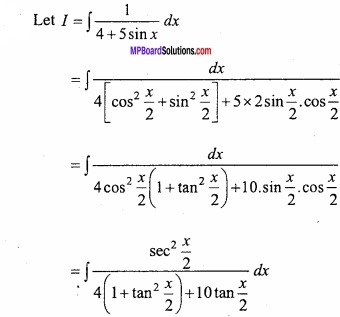
Let tan \(\frac { x }{ 2 }\) = t ⇒ sec2 \(\frac { x }{ 2 }\).\(\frac { 1 }{ 2 }\).dx = dt
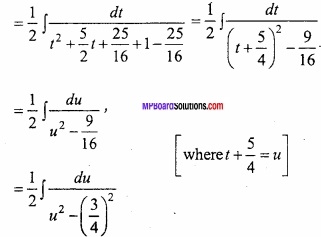
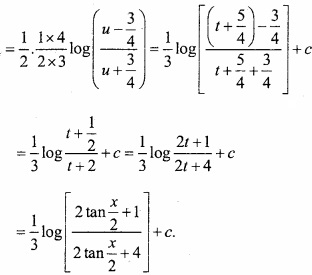
Question 10.
Evaluate \(\int { \frac { e^{ x }(1+sinx) }{ (1+cosx) } } \) dx?
Solution:
Let I = \(\int { \frac { e^{ x }(1+sinx) }{ (1+cosx) } } \) dx
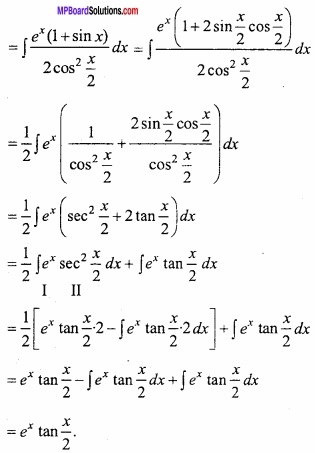
![]()
Question 11.
Evaluate \(\int { \frac { xe^{ x } }{ (1+x)^{ 2 } } } \) dx?
Solution:
Let I = \(\int { \frac { xe^{ x } }{ (1+x)^{ 2 } } } \) dx = \(\int { \frac { (1+x-1)e^{ x } }{ (1+x)^{ 2 } } } \)
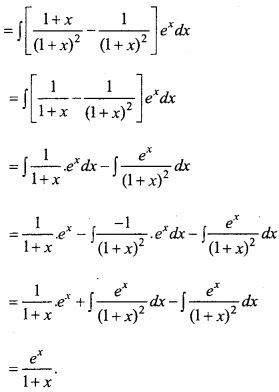
Question 12.
Evaluate \(\int { \frac { 2cosx }{ (1-sinx)(1+sin^{ 2 }x) } } \) dx? (CBSE 2018)
Solution:
Let I = \(\int { \frac { 2cosx }{ (1-sinx)(1+sin^{ 2 }x) } } \) dx
Put sin x = t, cos x dx = dt

⇒ 2 = A(1 + t2) + (1 – t) (Bt + 1)
⇒ 2 = A + At2 + Bt – Bt2 + 1 – t
⇒ 2 = (A – B)t2 + (B – 1) t + (A + 1)
Comparing the cofficient of like terms
∴ A – B = 0
B – 1 = 0
and A + 1 = 2
∴ B = 1, A = 1
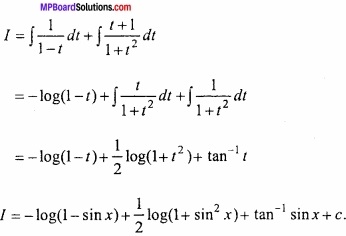
Question 13.
Evaluate \(\int { \frac { dx }{ e^{ x }-1 } } \)? (NCERT)
Solution:
Let I = \(\int { \frac { dx }{ e^{ x }-1 } } \) = \(\int { \frac { e^{ x }dx }{ e^{ x }(e^{ x }-1) } } \)
Again let ex = t, then exdx = dt
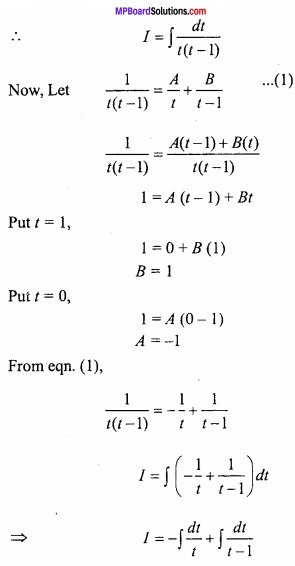
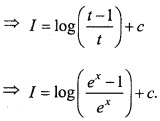
Question 14.
Evaluate \(\int { \frac { dx }{ x(x^{ n }+1) } } \)? (NCERT)
Solution:
Let I = \(\int { \frac { dx }{ x(x^{ n }+1) } } \)
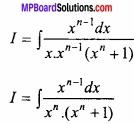
Put xn = t,
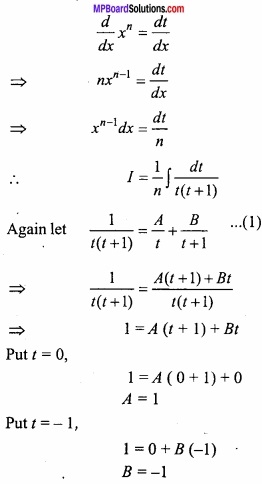

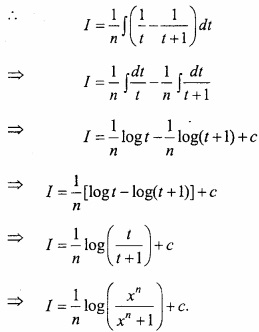
Question 15.
Evaluate \(\int { (\sqrt { tanx } +\sqrt { cotx) } } \) dx? (NCERT)
Solution:
Let
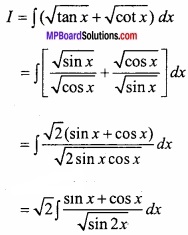
Again let, sin x – cos x = t
(cos x + sin x) dx = dt
(sin x – cos x)2 = t2
sin2x + cos2x – 2sinxcos x = t2
⇒ 1 – sin 2x = t2
⇒ sin 2x = 1 – t2
